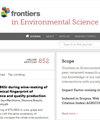Woodland expansion and upland management strategy dilemmas for biodiversity and carbon storage in the Cairngorms national park
IF 3.3
3区 环境科学与生态学
Q2 ENVIRONMENTAL SCIENCES
引用次数: 0
Abstract
Nature-based solutions are increasingly advocated to mitigate climate change and biodiversity loss, while improving ecosystem resilience and providing additional ecosystem services. In Scotland, woodland expansion and restoration of degraded peatlands are expected to play a major role in meeting net-zero emissions by 2045 and have prompted debates about the impact of increased woodland cover and prescribed fire on the biodiversity and ecosystem services provided by upland landscapes. In alignment with national policy, the Cairngorms National Park, the UK’s largest national park, has committed to an ambitious programme of woodland expansion and peatland restoration in a landscape dominated by heather moorlands that is predominantly managed through prescribed burning for game management. Using the Native Woodland Model and the InVest modelling platform, we assessed the effects of five land cover and land use change scenarios, with different levels of prescribed fire regulation and woodland expansion, to evaluate their benefits and costs on biodiversity and carbon sequestration. Results show that changing the extent and management of habitats will result in different carbon sequestration pathways, as well as biodiversity winners and losers. The scenario presenting greater benefits for the conservation of biodiversity also has lower above-ground carbon sequestration potential and a larger negative impact on red grouse habitats, thus being less profitable to sporting estates. Hence, trade-offs will be necessary to achieve optimal carbon sequestration and biodiversity gains, with a potential role played by the continuation of prescribed fires and traditional moorland management practices as well as complementary grants and support measures based on biodiversity benefits rather than carbon sequestration. The results from this study could support discussions regarding future management of the uplands, trade-offs between loss of carbon in soils, carbon sequestration in woodlands and conservation of biodiversity, as well as stakeholders likely to be affected.林地扩张和高地管理战略对凯恩戈姆国家公园生物多样性和碳储存的困境
人们越来越多地提倡以自然为基础的解决方案,以减缓气候变化和生物多样性的丧失,同时提高生态系统的恢复能力并提供额外的生态系统服务。在苏格兰,林地的扩大和退化泥炭地的恢复预计将在 2045 年实现净零排放方面发挥重要作用,这也引发了关于增加林地覆盖率和明火对高地景观所提供的生物多样性和生态系统服务的影响的讨论。为了与国家政策保持一致,英国最大的国家公园--凯恩戈姆国家公园(Cairngorms National Park)已承诺在以石楠荒地为主的地貌中实施一项雄心勃勃的林地扩展和泥炭地恢复计划,该地貌主要通过规定的焚烧进行野味管理。利用原生林地模型和 InVest 建模平台,我们评估了五种土地覆盖和土地利用变化情景的影响,以及不同程度的规定焚烧管理和林地扩展,以评估其对生物多样性和碳封存的效益和成本。结果表明,改变栖息地的范围和管理将导致不同的碳封存途径,以及生物多样性的赢家和输家。对保护生物多样性有更大益处的方案,其地面固碳潜力也较低,对红松鸡栖息地的负面影响也较大,因此对体育庄园来说利润较低。因此,为了实现最佳固碳效果和生物多样性收益,有必要进行权衡,而继续使用规定的火种和传统的荒地管理方法以及基于生物多样性收益而非固碳效果的补充补助和支持措施则有可能发挥作用。这项研究的结果将有助于讨论高地的未来管理、土壤碳损失、林地碳固存和生物多样性保护之间的权衡以及可能受到影响的利益相关者。
本文章由计算机程序翻译,如有差异,请以英文原文为准。
求助全文
约1分钟内获得全文
求助全文
来源期刊

Frontiers in Environmental Science
Environmental Science-General Environmental Science
CiteScore
4.50
自引率
8.70%
发文量
2276
审稿时长
12 weeks
期刊介绍:
Our natural world is experiencing a state of rapid change unprecedented in the presence of humans. The changes affect virtually all physical, chemical and biological systems on Earth. The interaction of these systems leads to tipping points, feedbacks and amplification of effects. In virtually all cases, the causes of environmental change can be traced to human activity through either direct interventions as a consequence of pollution, or through global warming from greenhouse case emissions. Well-formulated and internationally-relevant policies to mitigate the change, or adapt to the consequences, that will ensure our ability to thrive in the coming decades are badly needed. Without proper understanding of the processes involved, and deep understanding of the likely impacts of bad decisions or inaction, the security of food, water and energy is a risk. Left unchecked shortages of these basic commodities will lead to migration, global geopolitical tension and conflict. This represents the major challenge of our time. We are the first generation to appreciate the problem and we will be judged in future by our ability to determine and take the action necessary. Appropriate knowledge of the condition of our natural world, appreciation of the changes occurring, and predictions of how the future will develop are requisite to the definition and implementation of solutions.
Frontiers in Environmental Science publishes research at the cutting edge of knowledge of our natural world and its various intersections with society. It bridges between the identification and measurement of change, comprehension of the processes responsible, and the measures needed to reduce their impact. Its aim is to assist the formulation of policies, by offering sound scientific evidence on environmental science, that will lead to a more inhabitable and sustainable world for the generations to come.
 求助内容:
求助内容: 应助结果提醒方式:
应助结果提醒方式:


